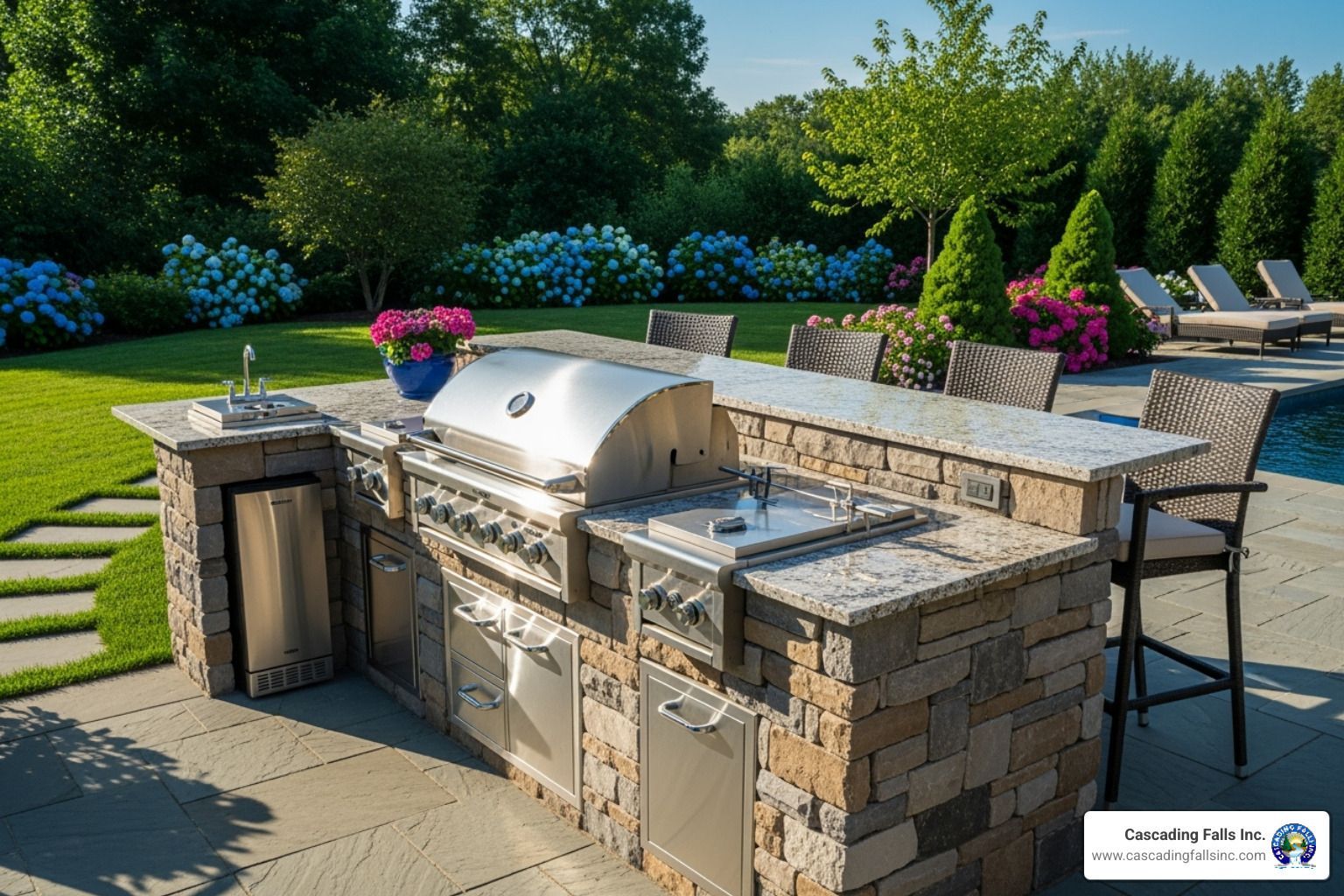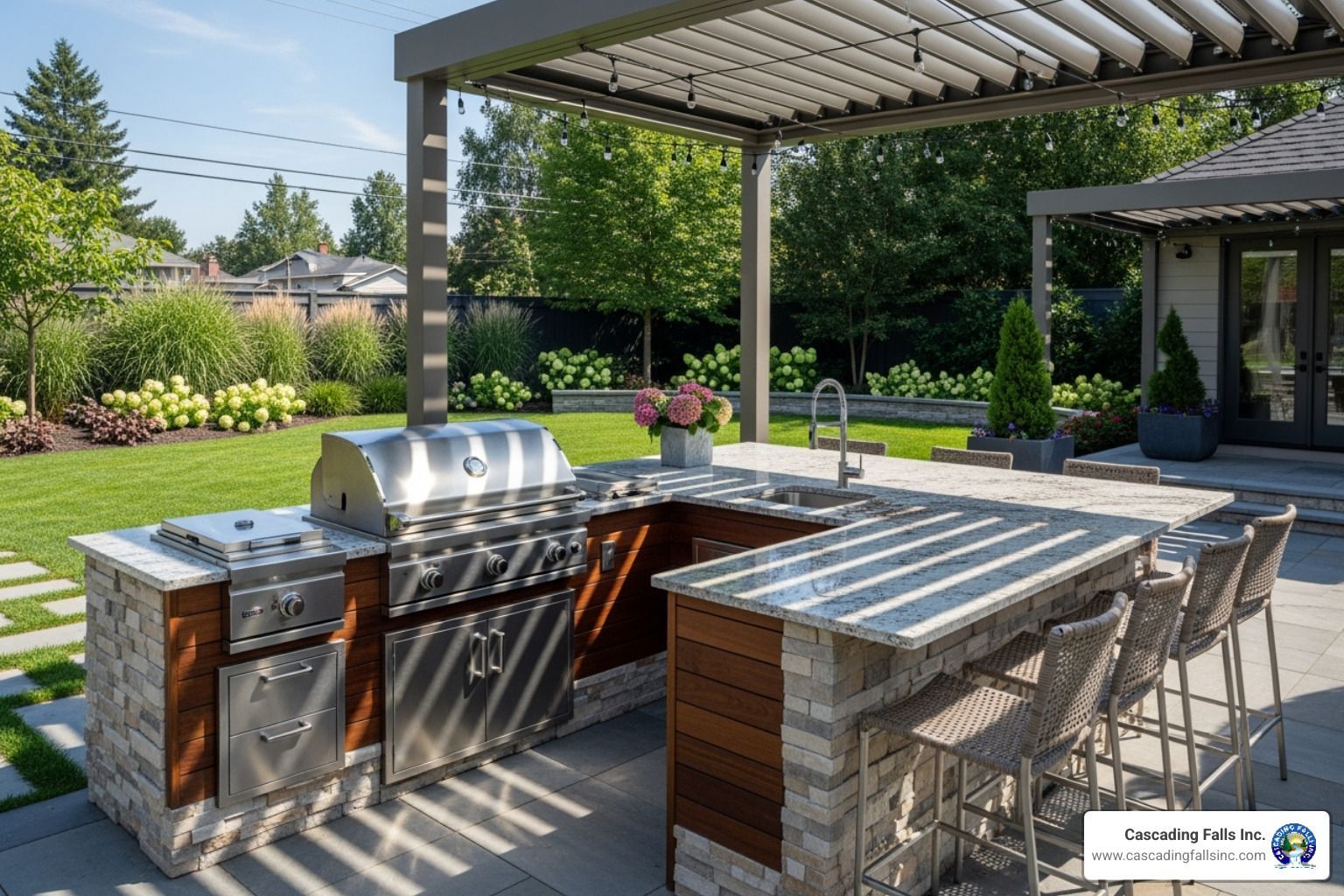Why a Pergola is the Perfect Upgrade for Your Compact Yard
A small garden pergola transforms tiny outdoor spaces into functional and beautiful living areas. Here are the top benefits for compact yards:
Key Benefits:
- Define zones- Create separate dining, lounging, or entrance areas
- Add vertical interest- Draw the eye upward to make spaces feel larger
- Provide partial shade- Comfortable outdoor use without full enclosure
- Support climbing plants- Maximize greenery without using floor space
- Increase home value- Pergolas add architectural appeal and functionality
Popular Small Pergola Sizes:
- 8x8 feet for cozy seating areas
- 10x10 feet for dining spaces (most popular size)
- Wall-mounted designs to save floor space
Whether you have a tiny patio or a compact backyard, the right pergola creates an outdoor room that feels both intimate and open. Research shows that pergolas can cost as little as $1,000-$2,000 for DIY materials, making them an affordable upgrade that delivers big visual impact.
Small gardens benefit most from pergolas because these structures maximize limited space through vertical design. A well-placed pergola becomes a focal point that organizes your outdoor area and creates the feeling of having distinct "rooms" outside.
I'm David Shellu, and with nearly two decades in landscape construction, I've helped countless clients find how a thoughtfully designed small garden pergola can completely transform their outdoor living experience. My background includes 15 years of owning a landscape construction business, where I specialized in creating custom outdoor structures that maximize both beauty and functionality in compact spaces.

5 Inspiring Pergola Ideas for Small Gardens
When you're working with a compact outdoor space, every design choice matters. The good news? A small garden pergola can transform even the tiniest yard into something special. I've seen homeowners turn overlooked corners into favorite gathering spots and awkward spaces into charming retreats.
Let me share five creative approaches that prove you don't need a sprawling backyard to enjoy the beauty and function of a pergola.
1. The Wall-Mounted Space-Saver
If your patio feels cramped, a wall-mounted pergola might be exactly what you need. Instead of using four posts that eat up precious floor space, this design attaches directly to your house. Think of it as borrowing space from above rather than stealing it from below.

What I love about attached pergolas is how they seamlessly extend your living area outdoors. Step out your back door, and you're immediately under a defined outdoor room. It's perfect for morning coffee or evening dinners without feeling like you're sitting in the middle of your yard.
These work especially well for townhouses and urban gardens where every square foot counts. You get the shade and architectural beauty of a pergola while maximizing your usable floor space for furniture and activities.
More info about our home improvement services
2. The Cozy Corner Retreat
Got an awkward corner that just sits there doing nothing? A corner pergola can turn that dead space into your favorite spot in the garden. These L-shaped designs fit snugly into 90-degree angles, making the most of areas that usually get ignored.
Picture this: a small corner pergola with L-shaped seating, a side table for your coffee, and maybe some climbing jasmine for natural privacy screens. Suddenly, that forgotten corner becomes your personal reading nook or quiet conversation area.
The beauty of corner pergolas lies in how they create an intimate, enclosed feeling without walls. You get the sense of having your own little outdoor room, perfect for those moments when you want to escape and unwind.
See more inspiration in our project gallery
3. The Walkway & Entrance Framer
Here's a creative twist: use your small garden pergola as a grand entrance rather than a sitting area. These arbor-style structures frame pathways, garden gates, or the entrance to different areas of your yard.
When you support climbing plants on these walkway pergolas, magic happens. Imagine walking under a canopy of fragrant roses or colorful wisteria every time you enter your garden. It transforms a simple stroll into something special.
These entrance framers add serious curb appeal and make even small gardens feel grand and thoughtfully designed. They guide your eye upward and create that "secret garden" atmosphere that makes neighbors stop and admire.
4. The Freestanding Focal Point
Don't assume a freestanding pergola is too big for your small garden. When placed strategically, it becomes a powerful focal point that anchors your entire layout. Think of it as creating a destination within your outdoor space.
A 10x10 pergola is actually the sweet spot for most small gardens. Yes, it sounds large, but this size creates a cozy and intimate space that's perfect for a full dining set or comfortable seating area. It's substantial enough to feel like a real outdoor room without overwhelming your yard.
I've seen homeowners use freestanding pergolas to define dining areas, create fire pit zones, and even establish dedicated spaces for yoga or morning meditation. It becomes the heart of your outdoor living experience.
5. The Green Canopy for Plant Lovers
If you love plants but lack garden space, a living pergola is your answer. Instead of just having a structure, you get a lush green canopy that provides natural shade and incredible beauty.

This approach maximizes your vertical gardening potential without using precious ground space. Climbing plants like roses, grape vines, or even edible plants like kiwi can transform your pergola into a living roof. You get shade, beauty, and sometimes even fresh fruit!
The plants create a cooler microclimate underneath and bring that wonderful biophilic design element that makes outdoor spaces feel more connected to nature. It's like having your own private garden room with a living ceiling.
See our landscaping services for plant integration
Key Design Considerations for Your Small Garden Pergola
Planning a small garden pergola is like solving a delightful puzzle. Every decision matters when you're working with limited space, and the difference between "perfect" and "overwhelming" often comes down to a few key choices. After years of helping homeowners transform their compact outdoor spaces, I've learned that success comes from thinking carefully about three main areas: size, light, and placement.
Choosing the Right Size for a small garden pergola
The biggest mistake I see? Homeowners falling in love with a pergola that's simply too big for their space. It's like buying a beautiful couch that won't fit through your front door – heartbreaking and impractical.
Scale and proportion are your best friends here. Your pergola should feel like it belongs, not like it landed from outer space. I always tell clients to imagine their pergola as part of a conversation with their house, fence, and existing garden features. Everything should feel balanced and harmonious.
When considering footprint versus garden size, think about how much of your outdoor space you're comfortable dedicating to the structure. A 10x10 pergola remains the most popular choice because it creates a genuinely cozy atmosphere while providing enough room for a full dining set. But don't feel pressured to go big – an 8x8 or 8x10 might be perfect for truly tiny spaces, giving you functionality without sacrificing that precious sense of openness.
Height considerations matter more than you might think. Too short, and you'll feel cramped. Too tall, and it looks like a watchtower. We aim for heights that allow comfortable movement underneath while staying in visual harmony with your home's roofline and surrounding structures.
The secret to avoiding overwhelming the space often lies in choosing slender posts and beams over chunky ones. Think neat rather than massive. A pergola with delicate proportions can actually make a small garden feel larger by drawing the eye upward without dominating the view.
Maximizing Light and Airiness
One of the most beautiful things about a pergola is how it plays with light. Unlike a solid roof that creates a dark cave, a pergola's open-beam design filters sunlight, creating those magical dancing shadows that make outdoor spaces feel alive.
This light-filtering quality is especially crucial in small gardens, where you can't afford to lose brightness or create dark corners. The gaps between the beams are what make the magic happen – you can adjust their spacing to control exactly how much sun filters through.
Light-colored materials work wonders for keeping things bright and airy. There's a reason white pergolas are so popular, with 137 different options available! White and other light colors like natural wood or soft grey steel reflect sunlight instead of absorbing it, making your entire space feel more open and expansive.
Choosing slender posts and beams over bulky alternatives contributes to that overall sense of lightness. Your pergola should feel like it's floating rather than sitting heavily in your garden.
For times when you need more coverage, optional shade features like retractable canopies or shade sails give you flexibility. Deploy them during those scorching afternoon hours, then tuck them away when you want full sun. It's like having the best of both worlds.
Strategic Placement and Zoning
Where you place your small garden pergola can make or break its success. This isn't about finding the only empty spot in your yard – it's about understanding how your garden works and how you want to live in it.
Start by watching your sun patterns throughout the day. Do you dream of morning coffee in gentle sunlight, or afternoon reading in cool shade? Your pergola's placement and orientation should support how you actually want to use your space.

Even in the smallest garden, a pergola can work magic by creating outdoor "rooms." Picture a defined dining area under your pergola with a separate lounging space nearby. This kind of spatial definition makes any garden feel more organized and intentional, like you've gained square footage without actually expanding your property.
Proximity to the house is another key decision. An attached pergola feels like an extension of your indoor living space – perfect for seamless entertaining. A freestanding pergola creates a destination, a special place that feels separate and retreat-like. Both approaches have their charm.
Consider using your pergola to frame a beautiful view – maybe that gorgeous mature tree, a water feature, or simply an interesting architectural element. It's like putting a picture frame around your favorite part of the garden.
Don't forget about the foundation. A pergola is only as good as what supports it, whether that's concrete footings or a properly designed patio base. Our concrete services ensure your pergola stands strong and stable for years of enjoyment.
The beauty of thoughtful placement is that it makes even the smallest garden feel purposeful and well-designed. Your pergola becomes more than just a structure – it becomes the organizing principle that ties everything together.
Choosing the Best Materials & Style
The material you choose for your small garden pergola will shape everything from its appearance to how much time you'll spend maintaining it. Think of it like choosing the foundation of your outdoor room – you want something that matches your lifestyle and stands up to your local climate.
Over the years, we've installed pergolas made from every material imaginable, and each has its own personality. Let me walk you through what we've learned works best for different situations.
Material Choices for a durable small garden pergola
When it comes to durability and style, you have some excellent options to choose from. Here's what we see most often and how they perform in real-world conditions:
| Material | Aesthetics | Cost | Maintenance | Lifespan |
|---|---|---|---|---|
| Wood | Natural, warm, classic, customizable stain | Moderate to High | Regular staining/sealing (annually) | 5 years (can extend to 10-12 with proper maintenance) |
| Steel | Modern, sleek, industrial, strong | High | Low (cleaning, occasional touch-ups on powder coat) | Very Long (decades, especially with powder coating) |
| Aluminum | Lightweight, contemporary, rust-resistant | Moderate to High | Low (cleaning) | Long (decades) |
| Composite | Low-maintenance, consistent color, wood-like | High | Very Low (cleaning) | Very Long (25+ years) |
| Vinyl | Clean, bright, low-maintenance | Moderate | Very Low (cleaning) | Long (20+ years) |
Wood remains the classic choice for good reason. Cedar and redwood are our go-to recommendations because they naturally resist decay and insects. There's something magical about the warm, organic feel of wood that just makes a garden feel complete. The downside? You'll need to commit to annual staining and sealing to keep it looking its best. With proper care, you can extend that typical 5-year lifespan to 10-12 years.
Steel pergolas have become incredibly popular – and we can see why. They offer best strength and that clean, modern look that many homeowners love. Powder-coated steel resists rust and can handle heavy loads, making it perfect if you want to hang swings or support heavy climbing plants. While the upfront cost is higher, the decades of low-maintenance life make it a smart investment.
Aluminum brings the best of both worlds – lightweight yet durable, with natural rust resistance. We often recommend aluminum for clients who want contemporary styling without the weight of steel. It's particularly great for retractable canopy systems.
Composite materials offer the wood look without the wood maintenance. Made from recycled materials and wood fibers, composite pergolas resist everything that typically damages wood – rot, insects, warping, and fading. The color goes all the way through, so scratches don't show.
Vinyl provides that crisp, clean appearance that works beautifully in small spaces. It's virtually maintenance-free and typically comes in white, which helps maximize light – perfect for a small garden pergola.
Adding Privacy, Light, and Personality
Once your pergola structure is in place, the real fun begins. This is where you transform a simple framework into your personal outdoor sanctuary.
Outdoor curtains work like magic for creating instant privacy and controlling sunlight. During the day, tie them back for an open feel. In the evening, draw them closed for intimate dining or conversation. We love how they add softness and movement to the structured lines of a pergola.
Latticework panels provide permanent privacy while still allowing air circulation. They're perfect for supporting climbing plants and creating semi-private screens. We often install them on one or two sides of a pergola to block views from neighbors while keeping the space feeling open.
Hanging plants bring life to your pergola immediately. Cascading flowers or trailing foliage add color and softness to the architectural lines. They're also a great way to add that green canopy effect without waiting years for climbing plants to mature.
Lighting transforms your pergola from a daytime structure to an evening destination. String lights create that magical ambiance everyone loves, while pendant lights provide functional illumination for dining or reading. The key is layering different types of lighting to create depth and atmosphere.
Personal touches make all the difference. Outdoor rugs define the space and add comfort underfoot. Colorful cushions and throws make seating areas inviting. Even a piece of outdoor art or a unique planter can turn your pergola into a true extension of your indoor style.
The beauty of these additions is that you can change them seasonally or as your tastes evolve. Your small garden pergola becomes a canvas for expressing your personality and creating the exact outdoor experience you've been dreaming of.
Frequently Asked Questions about Small Pergolas
When clients first reach out to us about adding a pergola to their compact outdoor space, they often have the same practical concerns. After years of helping homeowners create beautiful outdoor spaces, we've learned these questions are perfectly natural - and we're always happy to provide honest, straightforward answers.
How much does it cost to build a small pergola?
The investment for a small garden pergola depends on several key factors, and we believe in being completely transparent about what influences the final price.
If you're considering the DIY route, you can expect to spend $1,000 to $2,000 on materials alone. This range covers everything from basic pressure-treated lumber to higher-quality cedar or steel components. Many home improvement stores offer pergola kits within this price range, which can simplify the building process considerably.
When you choose professional installation, the investment naturally increases because you're getting more than just materials. You're investing in expert design, quality craftsmanship, and proper installation that ensures your pergola will stand strong for years to come. While pergola kits in the $1,000 to $1,499 range are widely available, a professionally designed and installed small pergola represents a higher investment - but one that delivers peace of mind and exceptional results.
Material choice significantly impacts cost. Wood options like cedar or redwood offer natural beauty at a moderate price point, while steel, aluminum, and composite materials command higher upfront costs but often provide better long-term value through reduced maintenance needs.
We always provide detailed, transparent quotes that break down both material and labor costs, so you know exactly what you're investing in before we begin.
What maintenance does a pergola require?
The beauty of choosing the right pergola material is that maintenance can range from minimal to practically nonexistent, depending on what you select.
Wooden pergolas require the most attention but reward you with natural warmth and classic appeal. Without regular care, a wooden pergola typically lasts about five years. However, with proper maintenance - including annual cleaning, staining, and sealing - you can extend its life to 10 to 12 years. This protective routine guards against moisture damage, UV rays, and insect problems.
Steel, aluminum, and composite pergolas are maintenance champions. These materials generally need only occasional cleaning with soap and water to remove accumulated dirt and grime. Steel pergolas with powder-coated finishes resist rust beautifully, while aluminum naturally fights corrosion. Composite materials are engineered to resist rot, warping, and insects with minimal fuss.
Regardless of your material choice, it's wise to periodically check all hardware and connections, especially after storms or high winds. Ensuring everything stays tight and secure is a simple step that protects your investment.
We're always happy to share specific maintenance tips for your chosen pergola material, helping you keep it looking beautiful and functioning perfectly for many years.
Do I need a permit to build a pergola?
This question deserves careful attention because the answer varies significantly based on where you live and what type of pergola you're planning.
Local building codes and zoning laws are the ultimate authority here, and they can differ dramatically from one city to another. What's perfectly fine in one area might require permits in another. These regulations exist for important safety reasons and to ensure all structures meet local standards.
Attached versus freestanding pergolas often face different requirements. Pergolas connected to your house are typically more likely to need permits since they're considered extensions of your dwelling. However, even freestanding structures above certain sizes or heights might trigger permit requirements.
Foundation type matters too. The kind of anchoring system your pergola needs - whether simple ground anchors or concrete footings - can influence permit requirements. Proper foundation work is essential for safety and stability.
Here's our strongest advice: always check with your local building department before starting any pergola project. Whether you're in Roseville, Sacramento, or anywhere else in California, a quick call to your municipal planning office can save you significant headaches later. Skipping required permits can lead to fines, forced removal, or complications when you eventually sell your home.
We're experienced in navigating the permitting process and can help ensure your small garden pergola project meets all local requirements from the very beginning.
Conclusion: Bring Your Small Garden Vision to Life
Your journey through these pergola possibilities shows just how much potential lies hidden in even the tiniest outdoor spaces. A small garden pergola truly is a game-changer - it's that one feature that can completely transform how you experience your backyard, no matter how compact it might be.
Think about it: we've explored how these structures create intimate outdoor rooms where none existed before, provide that perfect balance of shade and openness, and even boost your home's value. Whether you're drawn to the space-saving genius of a wall-mounted design or the lush beauty of a plant-covered green canopy, there's something magical about how a pergola makes a small space feel both cozy and expansive at the same time.
The beauty lies in the details we've covered - choosing the right size so it feels just right (not too big, not too small), picking materials that match your lifestyle and budget, and placing it where it'll make the biggest impact. It's not about having the most space; it's about making the most of the space you have.
Planning is everything. Getting the scale right, understanding how the sun moves through your garden, and selecting materials that'll stand up to your local climate - these considerations ensure your pergola becomes a beloved feature for years to come, not just a pretty addition that doesn't quite work.
We know that turning these ideas into reality can feel overwhelming. That's where professional guidance makes all the difference. For professional design and installation that takes the guesswork out of the process, the experts at Cascading Falls Inc. bring decades of experience to every project. With our commitment to quality, customer satisfaction, and exceptional craftsmanship, we embody a "Whatever It Takes..." approach to ensure your small garden pergola becomes exactly what you envisioned.
Your perfect outdoor oasis is closer than you think. Ready to get started?
Explore our full range of landscaping and construction services to get started






